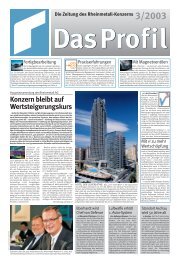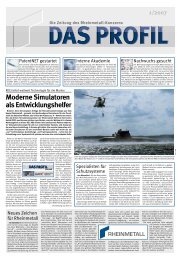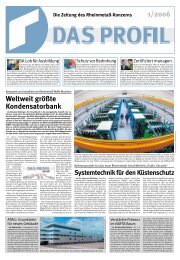PDF [1.6 MB] - Kolbenschmidt Pierburg AG
PDF [1.6 MB] - Kolbenschmidt Pierburg AG
PDF [1.6 MB] - Kolbenschmidt Pierburg AG
Create successful ePaper yourself
Turn your PDF publications into a flip-book with our unique Google optimized e-Paper software.
Newsline<br />
Eckernförde naval base welcomes press<br />
Success factor simulator<br />
experienced first-hand<br />
Eckernförde/Düsseldorf. Stormy winds<br />
greet the journalists as they get off<br />
their bus – hiding behind upturned collars,<br />
the more experienced naval writers<br />
mumble that this sort of weather is<br />
typical of the Baltic coast. Rheinmetall<br />
has invited the media to the Eckernförde<br />
naval base – and a good dozen<br />
representatives of the European media<br />
have accepted the invitation to this little<br />
town to the north-east of Kiel. Eckernförde<br />
has a long tradition as a garrison<br />
town and was the home port of<br />
German submarines in the days of the<br />
German Kaiser. Today, Eckernförde is<br />
home to the 1st submarine flotilla and<br />
the Specialized Naval Response Forces<br />
(SEK M) as well as the training center<br />
for submarines (AZU).<br />
Having entered the U31, a submarine<br />
of the new class U212A, the guests<br />
soon notice that one thing is scarce on<br />
board a sub – and that is space. Once<br />
they have maneuvered themselves<br />
more or less elegantly through the entrance<br />
hatch, the visitors are confronted<br />
with a confusingly large number of<br />
pipes, tubes, cables and levers. Not a<br />
square inch of the submarine is wasted.<br />
The fact that submarine crews con-<br />
sider the U212A submarine particularly<br />
comfortable and spacious comes as<br />
quite a surprise to the first-time visitor.<br />
Yet compared to older subs like the legendary<br />
VIIc in World War II or the 206A<br />
class submarine first taken into service<br />
in 1974, the new vessel is in a different<br />
league in terms of operational performance<br />
and comfort on board.<br />
Some of the visitors wonder how<br />
sailors manage in such constrained<br />
conditions under stress – in darkness<br />
or in the case of water ingress – while<br />
the naval officer explains the delights of<br />
a second wet cell (after all, the 206A<br />
submarine only has one such compact<br />
“bathroom”). Commander Volker Brasen,<br />
the commanding officer in charge<br />
of the training center for submarines is<br />
quick to supply an answer: “Training is<br />
crucial for submarine crews, even more<br />
so than in the past since the new 212A<br />
submarines are technologically far superior<br />
to their predecessors and therefore<br />
also much more complicated, so<br />
that the demands on crew training are<br />
naturally higher.”<br />
Simulation systems from Rheinmetall<br />
Defence in Bremen are an essential instrument<br />
offering outstanding naval<br />
training conditions. Every single training<br />
aspect can be trained on the simulator<br />
from Bremen – with training covering<br />
areas such as basic knowledge,<br />
for example how to maneuver and<br />
steer the submarine, or practising the<br />
interaction of the commanding crew<br />
under realistically simulated conditions<br />
and training emergency situations<br />
on board, e.g. if a fire has broken<br />
out or there is water ingress. The systems<br />
developed by Rheinmetall engineers<br />
in Bremen provide a genuine re-<br />
production of the combat information<br />
center (CIC) – using original components<br />
identical to those used on board<br />
submarines.<br />
“The Bundeswehr attaches considerable<br />
importance to realistic training<br />
conditions, both in terms of the technical<br />
equipment of the simulators and<br />
with regard to the scenarios presented,”<br />
says Claus Bornhorst, Head of<br />
Sales Maritime and Process Simulation<br />
at Rheinmetall Defence in Bremen. Explaining<br />
the advantages of this ap-<br />
4<br />
Eckernförde, home to the 1st submarine<br />
flotilla of the German Navy and the submarine<br />
training center equipped with simulation<br />
systems from Rheinmetall Defence.<br />
proach, Bornhorst remarks: “Although<br />
the original components are more expensive<br />
than non-originals, the reproduced<br />
CIC in the simulator is identical<br />
to the original so that training is extremely<br />
realistic.”<br />
Those who should know whether this<br />
is true – namely the submarine crews<br />
themselves – agree fully with Bornhorst’s<br />
appraisal: the general opinion<br />
Submarines of the class 212A are rated as the most modern of their type. Advanced simulation technology from Rheinmetall<br />
in Bremen has been used for the development of the vessels and training of the submarine crews.<br />
is that simulator training meets all the<br />
requirements with respect to technical<br />
safety and tactical training, and operation<br />
and control are easy to learn in<br />
spite of the many different functions.<br />
Commenting on his experience with<br />
the simulator, lieutenant commander<br />
Lars Ruth, commander of the U31,<br />
adds: “It feels just like being on board<br />
the real vessel.”<br />
The close cooperation between the<br />
navy and Rheinmetall Defence in Bre-<br />
(Continued on page 5)<br />
Photo: Presse- und Informationszentrum Marine<br />
Photo: HDW


![PDF [1.6 MB] - Kolbenschmidt Pierburg AG](https://img.yumpu.com/8657804/4/500x640/pdf-16-mb-kolbenschmidt-pierburg-ag.jpg)
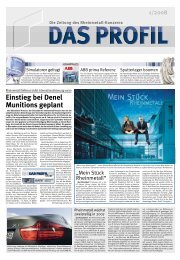



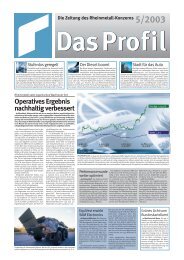
![PDF [2.4 MB] - Kolbenschmidt Pierburg AG](https://img.yumpu.com/8295864/1/184x260/pdf-24-mb-kolbenschmidt-pierburg-ag.jpg?quality=85)
![PDF [2.5 MB] - Kolbenschmidt Pierburg AG](https://img.yumpu.com/8112793/1/184x260/pdf-25-mb-kolbenschmidt-pierburg-ag.jpg?quality=85)




